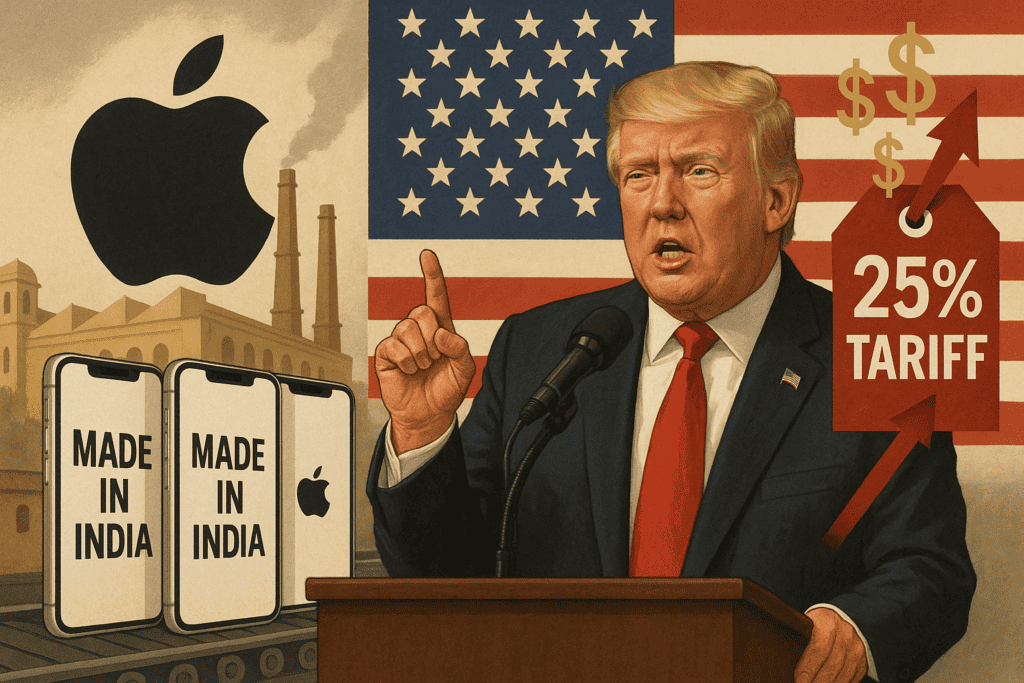It’s not every day that a former US President shakes up the global tech scene with a single social media post. But here we are. Trump’s 25% Tariff Threat on Apple is making headlines across the world, and it’s got everyone—from CEOs in Silicon Valley to engineers in Bengaluru—talking.
Let’s break down what’s happening, what it means for India, and why this drama could impact your next iPhone purchase.
What’s the Issue?
On May 23, 2025, Donald Trump posted on his platform, Truth Social, that Apple must manufacture iPhones in the United States if they want to sell them there—otherwise, they’ll face a 25% tariff. Yes, you read that right. Trump’s 25% Tariff Threat on Apple is real, and it’s causing ripples across markets.
Trump said he had already informed Apple CEO Tim Cook about this expectation. He wasn’t pleased with Apple’s increasing focus on manufacturing in India and warned that any iPhones not made in the US would attract a heavy import tax.
Why India Is in the Spotlight
India has been a growing hub for Apple’s manufacturing. In recent years, Apple shifted a big chunk of its iPhone production to India, especially in Chennai, where Foxconn is setting up a $1.5 billion plant. This move wasn’t just about cutting costs—it was Apple’s way of reducing dependency on China, especially after earlier US-China trade tensions.
But with Trump’s 25% Tariff Threat on Apple, India’s plans could be disrupted. If Apple decides to bend to Trump’s pressure, it may scale back its operations here. That’s bad news for local jobs, the Indian economy, and the growing trust international companies were placing in ‘Make in India.’
How This Affects Apple (and You)
If Apple continues with its Indian production and Trump’s tariffs come into play, expect iPhones to get more expensive in the US. A 25% import tax isn’t small—it could add hundreds of dollars to the retail price. And let’s be honest, iPhones are already expensive!
The alternative? Apple moves more of its manufacturing back to the US. But that would take years, involve massive investment, and likely still increase costs due to higher wages and operational expenses.
This puts Apple in a tough spot. Do they sacrifice margins and hike prices in their largest market? Or do they backtrack on global expansion and play by Trump’s rules?
Politics and Business: A Tricky Balance
This isn’t the first time Trump has gone after American companies for outsourcing. Walmart, Amazon, and even toy-maker Mattel have faced similar threats in recent months. Trump’s 25% Tariff Threat on Apple fits into a larger narrative of economic nationalism.
But here’s the thing: global supply chains are no longer simple. Apple’s ecosystem spans multiple countries, from software design in California to chip manufacturing in Taiwan and now assembly in India. Forcing it all back into one country isn’t just difficult—it’s near impossible in today’s global economy.
What’s Next?
As of now, Apple hasn’t issued a formal response. But analysts believe this won’t end quietly. Investors are already jittery—Apple’s stock dipped over 4% after Trump’s post.
For India, the hope is that Apple and other tech giants won’t be scared off. The country has made major strides in becoming a tech manufacturing hub, and backing out now would be a big blow.
So, whether you’re a tech enthusiast, a business owner, or just someone eyeing the new iPhone, Trump’s 25% Tariff Threat on Apple is something to keep an eye on. Because this isn’t just about politics—it’s about the future of tech, jobs, and the global economy.



